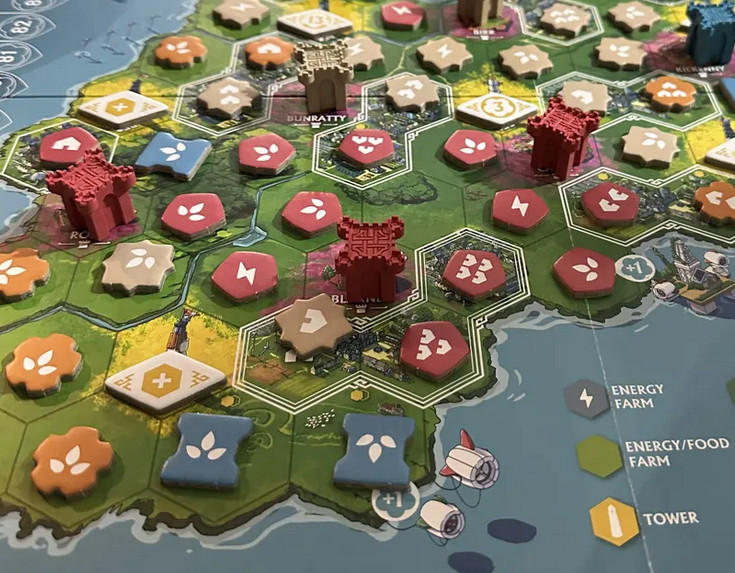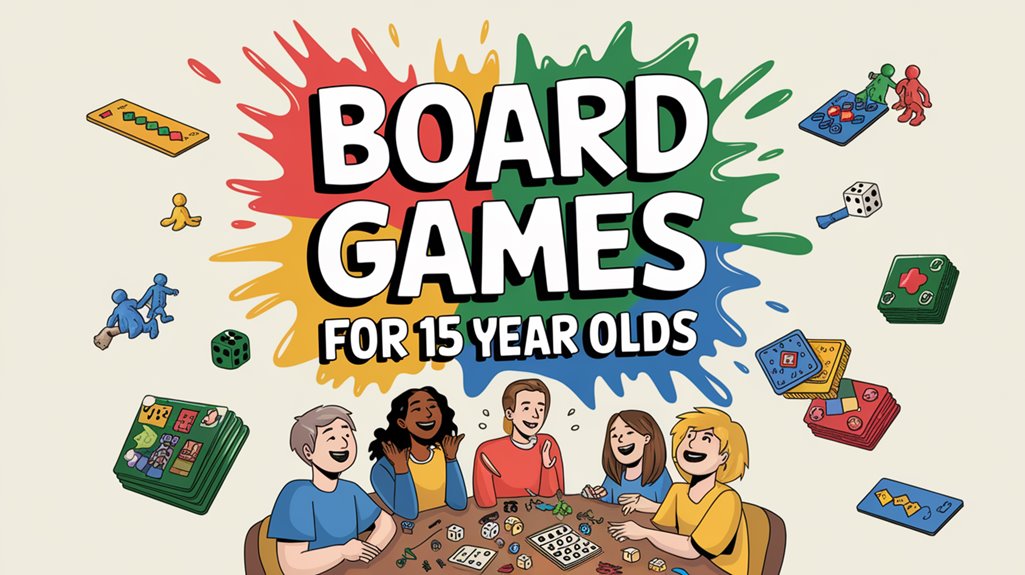Board gaming enthusiasts celebrate Reiner Knizia’s Rebirth for balancing accessibility with tactical depth. The game features a dual-sided board with Scottish and Irish variants, each offering unique strategic challenges through competitive tile placement as players vie for control of settlements and castles. Despite simple rules, Rebirth delivers a rich strategic experience worthy of closer study.
Key Takeaways
- Rebirth offers two distinct gameplay experiences on its dual-sided board, with Scottish hidden objectives and Irish public scoring systems.
- Players compete indirectly through castle control, strategic blocking, and expansion of contiguous tile groupings across the board.
- High-quality components include premium Rewood pieces and colorblind-friendly tiles, enhancing the overall aesthetic and tactile experience.
- The game encourages careful planning and observation of opponents’ moves without direct conflict, creating engaging multi-session gameplay.
Game Overview & Core Mechanics
Reiner Knizia showcases his mathematical design acumen in Rebirth through an elegant tile-laying system that balances simplicity with strategic depth. The dual-sided board offers distinct experiences: Scotland’s gameplay incorporates hidden objectives via private goal cards, while Ireland features public, tiered scoring objectives that all players compete for simultaneously. These regional variations maintain the same core placement mechanics while providing significantly different strategic considerations, effectively offering two games in one box.
Knizia’s Tile-Laying Brilliance
While many games in the tile-laying genre struggle to innovate beyond established formulas, “Rebirth” showcases Dr. Reiner Knizia’s genius through its elegant dual-sided board mechanism. The Scottish side rewards private achievements while the Irish encourages public competition, creating a fascinating strategic tension with each tile placement.
Knizia’s scoring system brilliantly balances immediate tactical decisions against long-term planning. Players must constantly evaluate whether to expand contiguous tile groupings, secure control of valuable castles, or fulfill objectives related to settlements and farms. The board state evolves organically as tiles accumulate, revealing new opportunities and challenges.
Despite its moderate complexity rating of 1.97, “Rebirth” delivers remarkable strategic depth while remaining accessible—a hallmark of Knizia’s finest designs in the tile-placement genre.
Scotland vs. Ireland Gameplay
The dual-sided board in “Rebirth” offers players a fundamental choice that shapes their entire game experience. Scotland presents a streamlined approach with private goal cards, rewarding players who focus on building contiguous tile groupings and claiming cathedral cards for end-game scoring.
In contrast, Ireland introduces a more complex scoring system featuring public objectives and round towers that provide tiered point opportunities. This side demands strategic planning to satisfy multiple scoring conditions simultaneously.
Both sides maintain the critical castle control mechanism, where each secured fortress yields five points at the end of each round. The divergent gameplay between Scotland and Ireland creates distinct strategic paths: Scottish play emphasizes personal objectives and territory consolidation, while Irish play balances public goals with territorial expansion—forcing players to adjust their approach depending on which side they choose.

Dual Board Design: Scotland Vs Ireland
The dual board design of Rebirth offers players a meaningful choice between the Scottish side, featuring private goals and cathedral-based end game scoring, and the Irish side, with its public tiered goals and combo-generating round towers. Each side presents distinctly different scoring approaches that demand tailored strategies, with the Scottish board rewarding long-term planning through hidden objectives while the Irish board encourages tactical adaptability through visible scoring opportunities. These regional variations transform what could have been a simple aesthetic difference into a substantial gameplay distinction, effectively creating two complementary experiences within a single box.
Dual Board Design Subheadings
Perhaps most innovative among Rebirth’s features is its dual-sided game board, offering players distinctly different gameplay experiences within a single box. The Scottish side presents a more straightforward approach with private goal cards and simplified scoring mechanisms, making it ideal for newcomers to the dual board design. Meanwhile, the Irish side enhances complexity through public objectives and a tiered scoring system that rewards strategic planning.
This thoughtful bifurcation extends beyond mere aesthetics—each side emphasizes different structures and spatial relationships. Scotland focuses on settlements and cathedrals, while Ireland introduces round towers that catalyze bonus combinations. Players score points differently depending on their chosen board, with contiguous tile placements rewarded uniquely on each side. This fundamental choice shapes not only point accumulation strategies but further the nature of player interaction throughout the game.
Different Scoring Approaches
Strategic depth in Rebirth emerges most prominently through its contrasting scoring systems across the dual boards. The Scotland side introduces private goal cards that create personalized scoring opportunities, compelling players to craft individualized strategies that others cannot easily disrupt or copy.
Ireland, conversely, employs public goals with tiered scoring that promote direct competition. This transparency transforms the gameplay into a tactical race where players must constantly adapt their strategic choices in response to opponents’ moves.
Both sides reward contiguous tile placement and castle control, with each castle worth five points at game end. Ireland adds another layer through its tower mechanics, enabling bonus scoring opportunities and combinations that skilled players can utilize. These distinct approaches guarantee that whether seeking personal achievement or competitive confrontation, players find liberation in pursuing their preferred path to victory.
Unique Strategic Considerations
While both sides of Rebirth’s dual board design share fundamental tile-placement mechanics, each offers distinctly tailored strategic experiences that dramatically alter gameplay approaches. The Scottish side emphasizes private objectives and personal strategy development through cathedral placement and hidden goal cards, creating a mighty puzzle of area control and tile adjacency optimization.
In contrast, Ireland’s layout introduces competitive tension through public goals with tiered scoring, pushing players toward direct confrontation over shared objectives. The addition of bonus-granting towers opens complex combo opportunities absent from Scotland’s more straightforward gameplay.
Castle control remains crucial regardless of which board gaming experience players choose, providing a consistent five-point reward that anchors strategic planning. Players must adapt their decision-making frameworks when switching sides, as familiar objectives require distinctly different approaches within each strategic environment.
Strategic Tile Placement & Scoring
Every placement decision in Rebirth carries significant weight as players navigate the dual-sided board’s scoring opportunities. The game rewards strategic foresight, requiring players to consider not just immediate points but future potential as they build contiguous groupings across both Scottish and Irish terrains.
Control of each castle space delivers a substantial five-point reward, making these territories hotly contested. The Scottish side’s private goal cards drive specialized placement strategies, while the Irish side’s public goals create dynamic competition with tiered scoring thresholds. Tower placements on the Irish side offer valuable combo opportunities that can dramatically alter scoring outcomes.
Players must constantly balance their visible moves against the uncertainty of tiles set aside by opponents, creating a tension-filled puzzle where anticipating future draws becomes crucial for maximizing points.
Player Interaction & Competitive Elements
Beyond the tactical placement decisions, Rebirth excels at creating meaningful player interaction in spite of lacking direct conflict mechanics. The game maintains a competitive atmosphere through strategic monitoring of opponents’ movements and calculated tile placements.
Players engage in a subtle battle for territory through:
- Strategic competition for control of valuable castles and Settlement icons
- Tactical blocking of opponents’ expansion routes to limit their scoring potential
- Adaptation to both private Scottish goals and public Irish objectives that other players pursue
- Careful observation of opponents’ tile placements to anticipate their strategies
The tension builds naturally as players draw hidden tiles, creating an environment where freedom of strategic expression meets the constraints of competitive positioning. This indirect interaction system rewards attentiveness and forward-thinking without relying on aggressive conflict mechanics.
Castle Control & Settlement Building
At the heart of Rebirth’s strategic terrain lies the dual mechanics of castle control and settlement building, which form the backbone of the game’s scoring system. Castles award players five points each at round’s end, making them hotly contested territories that demand tactical foresight and opportunistic play.
Settlement building complements castle control by enabling area majority scoring through strategic placement in designated zones. The Irish side introduces public goal cards that further shape players’ settlement strategies, requiring adaptability and long-term planning.
The game’s emphasis on contiguous tile groupings incentivizes players to construct settlements and capture castles in proximity, maximizing scoring potential. This creates a dynamic spatial puzzle where anticipating opponents’ moves becomes vital—players must continuously balance immediate castle control against developing settlement networks that can secure victory through territorial dominance.
Component Quality & Visual Design
Rebirth’s component quality stands as an indication of modern board game production values, with the inclusion of premium Rewood pieces that offer both tactile satisfaction and exceptional durability. The visual design demonstrates thoughtful attention to player experience and accessibility.
Key visual and component highlights include:
- Stunning box art by renowned artists Anna Przybylska and Kate Redesiuk that immediately establishes the game’s aesthetic appeal
- Accessibility-focused tile design that accommodates color vision deficiency without compromising visual impact
- Deluxe editions featuring opaque bags that improve both functionality during gameplay and overall presentation
- The Ireland side’s distinctive visual elements that complement its unique mechanical innovations
This commitment to component quality and visual design extends beyond mere aesthetics, creating an immersive experience that matches the strategic depth of the gameplay itself.
Accessibility & Learning Curve
While the premium components create an inviting first impression, the true gateway into Rebirth’s world lies in its remarkably accessible design philosophy. With a complexity rating of just 1.97 out of 5, the game positions itself perfectly for both newcomers and experienced players seeking strategic depth without overwhelming complexity.
The simple rules promote rapid gameplay immersion, allowing groups to begin playing within minutes rather than hours. Intuitive tile placement mechanics require minimal explanation, with visual design elements compensating for the necessary text on certain tiles. This thoughtful approach guarantees language barriers pose little obstacle to enjoyment.
Perhaps most significantly, Rebirth’s absence of direct player confrontation creates a stress-free environment where players can develop strategies at their own pace—a design choice that dramatically boosts accessibility for those new to modern board gaming.



